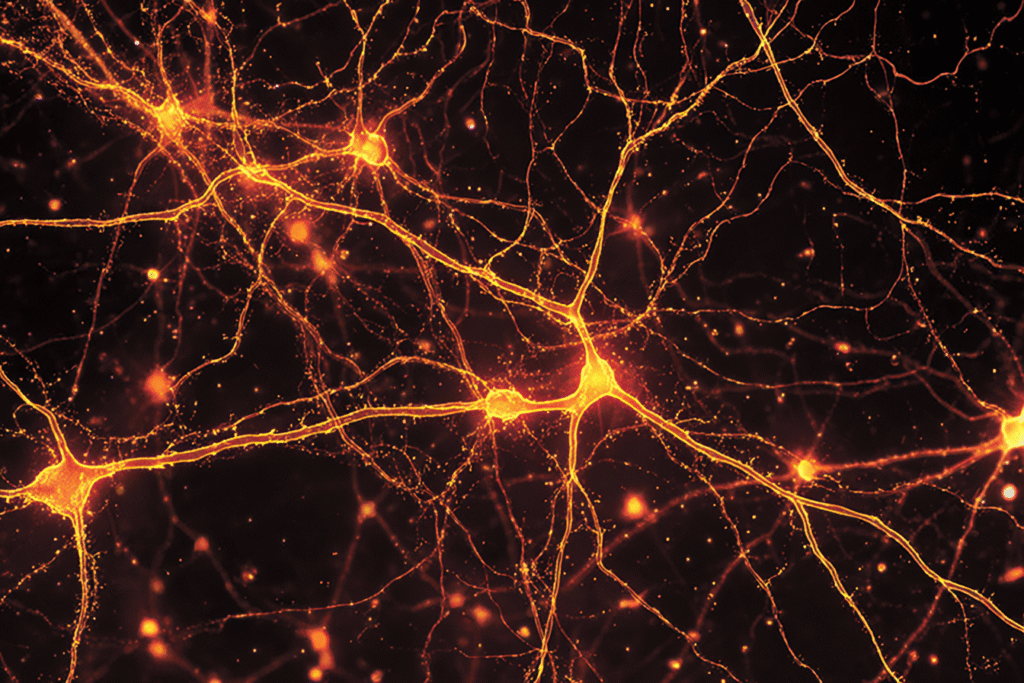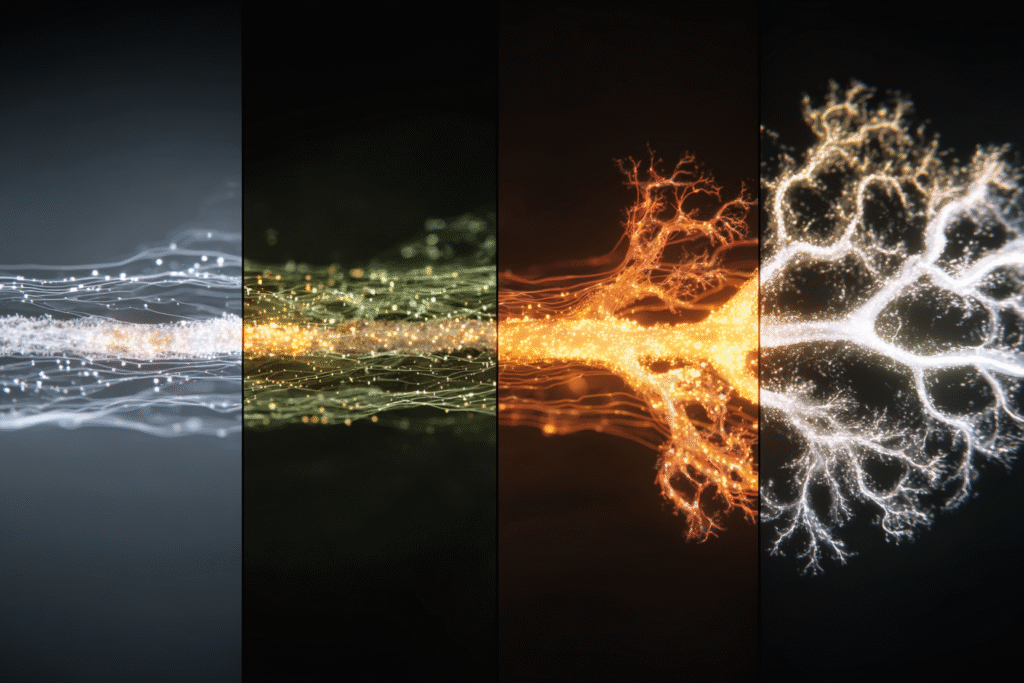The most dangerous lie your brain tells you is that you can’t change.
In our last article, we explored how your brain’s hidden filters—the RAS and thalamus—shape every moment of your conscious experience. We discovered that what you call “reality” is actually a highly curated feed, filtered through ancient survival systems and learned patterns you never consciously chose.
But here’s where most people get stuck: they assume these filters are permanent. They think, “This is just how I am. I’m not good with people,” or “I’m just not creative,” or “I’ll never be confident.”
What if I told you that belief itself is just another filter—one that’s been programmed through repetition and emotional intensity? And what if that filter is not only wrong, but actively preventing you from accessing your brain’s most remarkable capability?
After all my experience developing AI systems, I’ve learned that the most sophisticated learning algorithms pale in comparison to what your brain can do. Unlike the static neural networks we build in code, your brain rewrites itself continuously. Every thought, experience, and moment of focused attention literally reshapes your neural architecture.
This isn’t a metaphor—it’s measurable, physical change.
The scientific term is neuroplasticity—your brain’s ability to reorganize, adapt, and form new neural connections throughout your entire life. And here’s what’s remarkable: the same mechanisms that installed your current filters can be consciously directed to install new ones.
The question isn’t whether you can change your filters. It’s whether you will.
What Is Neuroplasticity?
Neuroplasticity is your brain’s ability to physically rewire itself based on experience, thought, and focused attention. Every time you learn something new, practice a skill, or even change how you think about a situation, you’re actively reshaping the neural pathways, the physical structures, in your brain.
At the molecular level, this happens through a principle neuroscientists call “Hebb’s Rule“:
Neurons that fire together, wire together.
When you repeatedly activate the same neural pathways, the connections between those neurons strengthen. The synapses become more efficient. Myelin sheaths thicken around frequently used pathways, making signals travel faster and more reliably.

Here’s what’s crucial for filter retraining: this process works in both directions.
When you stop using certain neural pathways—when you consciously choose different thoughts, reactions, or behaviors—those old connections weaken. Your brain literally prunes unused synapses, redirecting resources to the circuits you’re actively strengthening—like a gardener removing dead branches to help new growth flourish.
This means your current filters—the ones that make you notice threats instead of opportunities, problems instead of solutions, evidence of your limitations instead of your potential—aren’t permanent neural structures. They’re just well-traveled pathways that your brain has optimized through repetition.
And optimization can be redirected.
Your RAS and thalamus don’t distinguish between “helpful” and “unhelpful” patterns when deciding what to filter. They simply amplify whatever you consistently feed them through attention and emotion. If you repeatedly focus on what’s wrong, those detection circuits strengthen. If you consistently notice what’s working, those recognition pathways develop instead.
The breakthrough insight from neuroscience research is this:
Consciousness itself is malleable.
This means what you call ‘you’—your preferences, reactions, even what feels possible—isn’t fixed. It’s trained. And anything trained can be retrained. What you’re aware of, what you notice, what feels “real” to you—all of this can be systematically trained and upgraded.
But there’s a catch.
Neuroplasticity requires three specific conditions: focused attention, repetition, and emotional significance.
Random positive thinking won’t rewire deep patterns. Casual effort won’t override years of conditioning. You need a systematic approach that leverages how your brain actually changes.
Understanding both the requirements for change and why your brain resists it transforms how you approach the process. Here’s how I discovered this truth about my own perceived limitations.
Why Your Brain Resists Change
Before we dive into the practical methods, there’s something crucial to understand: your brain will resist this rewiring process. This isn’t a character flaw—it’s a feature, not a bug.
Your current filters exist because they once served a purpose. Even limiting beliefs typically developed as protective mechanisms. Your brain invested significant energy building these neural pathways, and it won’t abandon them without evidence that the new patterns are genuinely better.
This means you’ll experience what neuroscientists call ‘cognitive resistance’—moments when your old patterns feel more comfortable, when change feels impossible, when you question whether this rewiring actually works. These moments aren’t failures; they’re proof that you’re reaching the edges of your current neural programming.
The key is recognizing resistance as a sign of progress, not a reason to quit. Every moment of discomfort is your brain building new circuits while the old ones fight to stay relevant.
This resistance showed up clearly in my own transformation journey.
Limiting Beliefs = Outdated Filters
At 14, I carried what felt like an unchangeable truth: I wasn’t good at communicating. My immigration to Canada brought years of awkward conversations and social missteps that programmed my RAS to filter every interaction through the lens of “I’m bad at this.”

Then I had a realization that changed everything:
“This wasn’t a personality flaw—it was just an outdated filter.”
Like most limiting beliefs, mine had been installed through repetition and emotional intensity. My brain had simply strengthened whatever pattern I repeatedly fed it through my attention. I’d been unconsciously training my RAS to notice communication failures while filtering out any evidence of success.
Once I understood this, I started treating my limiting belief like any other filter that needed conscious recalibration. Instead of automatically scanning for what could go wrong, I began noticing when conversations flowed well. Instead of reinforcing the “I’m bad at this” pattern, I started practicing “I’m learning this.”
The change didn’t happen overnight, but it happened. My brain rewired itself around completely different filtering patterns. Today, communication is one of my core strengths, even if it’s still a work in progress—not because I discovered some hidden talent, but because I systematically updated old programming through practice and repetition.
This is the truth about every single limiting belief you carry: it’s not permanent reality. It’s just a filter that got overtrained in one direction and needs conscious recalibration in the other.
Your brain doesn’t distinguish between “helpful” and “limiting” beliefs when encoding them. It simply strengthens whatever you repeatedly practice. Which means the same neuroplastic principles that installed your limitations can just as easily be reprogrammed to install your capabilities.
That insight—that beliefs are trainable, physical patterns—opened the door to something deeper: a structured way to reprogram them deliberately.
Which brings us to an upgraded framework built on exactly that principle.
FILTER 2.0: Rewiring Through Neuroplastic Precision
Understanding these neuroplastic principles transforms how we approach filter retraining. This isn’t just about changing what you think—it’s about systematically reshaping the neural pathways that determine what you notice and how you respond.

Here’s how to upgrade the FILTER method with this deeper knowledge:
F – Frequency: Synaptic Strengthening Through Repetition
Neuroplasticity requires consistent activation of target neural pathways. Your brain strengthens whatever you repeatedly fire together. This means sporadic effort won’t create lasting change—you need deliberate, consistent practice.
The key takeaway:
Your RAS updates its filtering priorities based on frequency of exposure, not intensity of experience. Spending 10 minutes daily focused on solutions-detection will rewire your attention more effectively than a single 3-hour breakthrough session.
Create micro-practices throughout your day:
Notice three things working well each morning. When challenges arise, ask yourself ‘What opportunity does this create?’ Practice these neural pathways through small, consistent repetitions.
I – Imagination: Mental Rehearsal Creates Neural Pathways
Your brain processes vivid imagination almost identically to real experience. When you repeatedly visualize yourself noticing opportunities, responding confidently, or seeing solutions clearly, you’re literally pre-building the neural pathways you’ll need in actual situations.
Studies using fMRI scans have shown that mental rehearsal activates the same brain regions as actual experience—making visualization a real form of neural conditioning.
The neuroplastic upgrade:
Make your visualizations as detailed and multi-sensory as possible. See the environment, hear the conversations, feel the emotions of success. The more specific your mental rehearsal, the more precisely you’re programming your filtering systems.
Spend 5-10 minutes daily mentally rehearsing the version of yourself who naturally notices what you want to see. Your brain will begin building those recognition patterns before you ever encounter the real situations.
L – Linking: Emotional Circuits Accelerate Rewiring
Emotion doesn’t just make memories stick—it turbocharges neuroplastic change. When you pair new filtering patterns with strong positive emotion, you activate the neurochemical cocktail that accelerates synaptic strengthening.
Connect your filter retraining to something that matters deeply to you. Don’t just practice noticing opportunities—link it to your mission, your values, the person you’re becoming. When your brain registers emotional significance, it prioritizes that neural pathway development.
This is why my communication breakthrough happened so quickly at 14. The moment I connected better communication to my deeper goals and identity, my brain treated it as survival-level important.
T – Targeting: Focused Attention Directs Neuroplastic Change
Your brain changes most efficiently when you direct focused attention toward specific outcomes. Scattered effort creates scattered results. Precise focus creates precise rewiring.
Choose one filtering pattern to retrain at a time. If you want to notice more solutions, spend weeks training your brain to automatically ask “How could this work?” rather than “Why won’t this work?” If you want to see more opportunities, practice the specific question “What possibility does this create?” until it becomes automatic.
Neuroplasticity follows attention.
Where you consistently direct your focus is what gets strengthened.
E – Evaluation: Awareness of Progress Reinforces New Patterns
Your brain strengthens circuits that it recognizes as valuable. When you consciously acknowledge improvements—even small ones—you’re sending feedback signals that reinforce the new neural pathways.
Track your filter changes as they happen:
Notice when you automatically spot a solution instead of getting stuck in a problem. Celebrate when you catch an opportunity others miss. Recognize when old reactive patterns don’t trigger like they used to.
This awareness creates a positive feedback loop that accelerates further change.
R – Recalibration: Continuous Adaptation as Neural Efficiency
As your new filtering patterns strengthen, your needs and context continue evolving. What served you during initial retraining might need adjustment as you grow.
Together, these six levers create a complete neural retraining loop—one you can apply to any limiting pattern and evolve over time.
Neuroplasticity allows for ongoing optimization—your brain can continuously refine and upgrade its filtering systems. You’re no longer just changing isolated patterns—you’re building a system that continuously upgrades itself.
Build regular assessment into your practice: What filters are serving you now? What patterns need updating? How has your growth changed what you need to notice?
Keep evolving your filtering systems as consciously as you initially trained them.
The Rewiring Protocol: Turn Insights into Transformation
FILTER 2.0 gives us the principles—but principles alone aren’t enough. Real rewiring requires structure.
The Rewiring Protocol combines both the FILTER method and the Backprop Loop we explored in Day 12, into a phased system that turns theory into lasting transformation.

Here’s how to systematically rewire and update the filters shaping your reality:
Phase 1: Pattern Recognition (Weeks 1-2)
Before you can change a filter, you need to catch it in action. Your current filtering patterns are largely unconscious—they’ve been automated through years of repetition.
Start with awareness-only practice:
For two weeks, simply notice your automatic filtering patterns without trying to change them. When do you automatically look for problems? What triggers your threat-detection circuits? When does your brain filter out positive information?
Use the Backprop Loop:
Notice the signal (your emotional or mental response), trace the gradient (what filter created this response?), but don’t make adjustments yet. Just observe and log the patterns.
This recognition phase is crucial. Neuroplasticity requires conscious attention, and you can’t consciously direct what you haven’t first consciously observed.
Phase 2: Single-Filter Focus (Weeks 3-6)
Choose one specific filter to retrain. Not three. Not six. One.
Maybe it’s shifting from automatic problem-spotting to automatic solution-seeking. Maybe it’s training your brain to notice opportunities instead of obstacles. Maybe it’s upgrading from threat-detection to connection-detection in social situations.
Apply enhanced FILTER method to this single pattern:
- Frequency: Practice the new filter 3-5 times daily through micro-exercises
- Imagination: Spend 5 minutes each morning visualizing yourself naturally using this new filter
- Linking: Connect this change to something emotionally significant
- Targeting: Create specific trigger questions that activate the new pattern
- Evaluation: Track daily instances where you caught the old pattern or used the new one
- Recalibration: Adjust your approach based on what’s working
Once your brain has begun building the basic neural pathways for your new filter—usually after 3-4 weeks of consistent practice—it’s time to strengthen those circuits through real-world application.
Phase 3: Integration and Automation (Weeks 7-12)
As your new filter begins to feel natural, integrate it with real-world challenges. This is where neuroplasticity moves from conscious practice to unconscious automation.
Use progressively challenging scenarios: Start with low-stakes situations where you can practice the new filter, then gradually apply it to more complex or emotionally charged contexts.
This is where the Backprop Loop becomes crucial: Notice when the new filter works well, trace what made it effective, then adjust to reinforce those conditions.
Your brain will begin to automate the new pattern when it recognizes consistent positive outcomes.
Phase 4: Stack and Expand (Month 4+)
Once your first filter change has become relatively automatic, you can begin training additional filters. But here’s the key: build on the foundation you’ve created rather than starting from scratch.
Your brain has now learned the meta-skill of filter retraining. Each subsequent change will happen faster because you’ve developed the neural infrastructure for conscious pattern modification.

Daily Practice Structure
Your daily practice should evolve with your rewiring progress. Here’s how to adapt your routine based on which phase you’re in:
Phase 1-2 Focus (Weeks 1-6):
- Morning (5 minutes): Set intention to notice your target filter in action
- Throughout day: Awareness-only practice—catch patterns without forcing change
- Evening (5 minutes): Log what you observed without judgment
Phase 3-4 Focus (Weeks 7+):
- Morning (10 minutes): Visualization of successful filter application + intention setting
- Throughout day: Active practice with real-world challenges
- Evening (5 minutes): Evaluate successes, adjust approach, celebrate progress
Universal Non-Negotiables (All Phases):
- Consistency over intensity—daily practice beats sporadic marathons.
- Patience with the process—While surface-level shifts can happen in weeks, deeper pattern rewiring typically takes 3–6 months of consistent input.
- Emotional connection—link changes to what matters most to you.
- Progress tracking—your brain needs feedback to know what to strengthen.
Remember: You’re not just changing your thoughts. You’re actively reshaping the neural pathways that determine what you notice, how you interpret information, and what feels “real” to you.
This is precision engineering of your own perception.
From Rewiring to Clarity Loops
Changing your filters doesn’t just change you—it reshapes the world you interact with, reinforcing those changes in return. This is where individual filter retraining evolves into something more sophisticated: integrated clarity systems that compound over time.
When I first started retraining my communication filters at 14, I thought I was just learning to be better at conversations. But what actually happened was far more profound.
As my communication improved, I started noticing different opportunities. Better relationships led to new perspectives. New perspectives revealed possibilities I’d been filtering out for years. Each improvement created conditions for further improvements.
Here’s a concrete example:
As I became more confident in conversations, people started approaching me with opportunities I’d never noticed before. These opportunities led to new relationships. New relationships exposed me to different perspectives. Different perspectives revealed assumptions I’d been carrying about what was possible in my life.
Soon, my improved communication filter had cascaded into upgraded filters for opportunity recognition, relationship building, and possibility thinking. What started as rewiring one limiting belief became a complete perceptual transformation—not because I tackled everything at once, but because I let one change naturally enable the next.
The rewiring process itself began to accelerate the reality I was experiencing.

This is what we’ll explore next: how individual filter changes integrate into comprehensive clarity systems—what I call “Clarity Loops.”
These feedback cycles combine conscious filter calibration, real-world action, and environmental reinforcement—creating continuous upgrades to your perception.
Because here’s the truth about neuroplasticity that most people miss: it’s not just about changing yourself. It’s about changing yourself in ways that change your environment, which then creates new opportunities for further positive change. Understanding this feedback loop is where individual change becomes systematic transformation.
Your brain doesn’t just adapt to reality—it helps create the reality it then adapts to.
Designing a Self-Reinforcing Reality
When you systematically retrain your filters, you’re not just improving isolated capabilities.
You’re building the foundation for a completely different way of engaging with the world—one where clarity becomes not just a momentary insight, but a continuous, self-reinforcing loop.
Tomorrow, we’ll map this integration in detail: how your newly rewired filters combine with conscious awareness, environmental feedback, and iterative refinement to create what might be the most powerful clarity technology we’ve overlooked.
Learning to work with this feedback loop is what turns isolated breakthroughs into an ongoing transformation system. The individual filters you’re rewiring today become the building blocks of tomorrow’s clarity systems.
Until then, start small: pick one filter, apply the protocol, and trust the process. Be patient with yourself—your brain is already beginning to change.
See you in the next insight.


